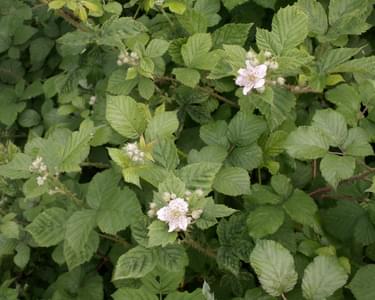Bramble
Other names
Blackberry
Latin names
Rubus fruticosus L. agg. ( R. sect. 2 Glandulosus)
Weed Type
Perennial Broad-leaved Weeds
Where would I find bramble?
Bramble is a woody perennial with long spiny stems that may be biennial to perennial. It is native in a range of natural and man-made habitats. Bramble occurs throughout Britain in hedgerows, scrub, woodland and wasteland. It can be a problem weed in gardens. It is absent from mown and grazed grassland and is most frequent in soils of pH 3.5 to 5.0. Brambles can form extensive thickets in open sites.
The brambles form a complex, group often referred to collectively as R. fruticosus L. agg.. Plants are very variable in almost all characters and over 300 microspecies are recognised. Some forms are less common on calcareous soils while others are widespread on chalk and clay. The taxonomy is still under investigation and field identification requires expert confirmation.
Although bramble is a weed in many situations, it is valued for its edible fruit and is often found in cultivation. The leaves have medicinal uses and the roots yield an orange dye. On footpaths and in semi-natural situations brambles can create a trip hazard with the looping shoots that root at the tips.
Biology
Bramble flowers from June to September and seed is set from September to October. There are around 20 seeds per blackberry fruit and 40,000 seeds per plant, but much of the seed is non-viable. Most bramble species are polyploids producing seeds by pseudogamy. Pollination is needed but there is no fusion of the male and female cells. However, seeds are sometimes produced through normal cross-pollination by insects.
Seed often does not germinate until the second year after shedding. Seeds have a hard seed coat and a chilling requirement to overcome. Plants take three years to flower from seed.
The stems bear flowers and fruit in their second year. In the autumn, the stem tips become positively geotropic and elongate rapidly to reach and penetrate the soil surface before developing adventitious roots and forming new plants. Daughter plants are more likely to develop in sheltered sites such as woodland margins than in exposed situations. Brambles may also regenerate from rooted stem fragments.
Does black bramble spread easily?
Reproduction is by seed, rooting of the stem apices and in some forms suckers that develop on the lateral roots. Suckers can emerge from roots that are 45 cm deep in soil. Brambles also regenerate from fragments of root and stem.
Bramble seeds can pass unharmed through the digestive system of birds and germination is often enhanced.
How to manage bramble organically
The roots are killed by frequent cultivation.
The production of daughter plants can be reduced by grazing with sheep, cattle or horses, and by mowing. However, cutting the stems at or near ground level stimulates the formation of suckers from the lateral roots. Brambles are important constituents in the diet of several types of deer but are not eaten by rabbits.
In Australia, where bramble was introduced by settlers and is now a serious weed problem, biological control studies with insects and fungi from its native habitats in Europe began in 1977. These include the rust fungus Phragmidium violaceum, the stem-boring sawfly Hartigia albomaculatus and the purple blotch fungus Septocyta ruborum. The rust fungus attacks the leaves, flowers and immature fruits. Larvae of the sawfly burrow into the emerging shoots and destroy the pith. The blackberry purple blotch fungus attacks the base of the new shoots and causes dieback of the plants.
